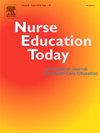Examination and testing of structural validity of the Confidence in Dementia Scale with nursing students. An international perspective
IF 3.6
2区 医学
Q1 EDUCATION, SCIENTIFIC DISCIPLINES
引用次数: 0
Abstract
Background
As the prevalence of dementia continues to rise globally, nurses are increasingly at the forefront of providing care. Effective dementia care relies on not just knowledge, but also the confidence to translate this knowledge into meaningful action. Enhancing nursing education programmes to build both knowledge and confidence is critical. As no studies have explored measuring confidence in dementia care over an extended period (beyond six months), there is a need for a rigorous and robust analysis of the Confidence in Dementia (CODE) Scale, to determine whether it is a psychometrically sound tool for assessing confidence over time.
Methods
A cross-sectional series design was used to collect longitudinal data from a census of nursing students over a 3-year period. A standardized instrument, the Confidence in Dementia Scale was administered repeatedly to a sample (time 1 n = 247; time 2 n = 239; time 3 = n = 216). Analyses were performed using SPSS for descriptive statistics and JASP for structural equation modelling. An initial exploratory factor analysis was conducted using the first data set to explore the factor structure. A confirmatory factor analysis was performed (on the second and third data sets) to confirm the factor structure and assess the model's overall validity. COSMIN guidelines inform the analysis process, and the findings are reported using STROBE guidelines.
Results
The factor structure replicated and confirmed the one factor structure identified by international findings. The findings confirm its usefulness of the Confidence in Dementia scale to gauge health professionals' confidence in dementia care before going into practice.
Conclusions
This study highlights the need for psychometrically valid tools that can measure confidence over an extended period, encompassing the three-year degree programme and beyond.
背景随着全球痴呆症发病率的持续上升,护士越来越多地站在提供护理的最前沿。有效的痴呆症护理不仅有赖于知识,还有赖于将知识转化为有意义行动的信心。加强护理教育计划以培养知识和信心至关重要。由于还没有研究对痴呆症护理的信心进行长期(超过六个月)的测量,因此有必要对痴呆症信心量表(CODE)进行严格、稳健的分析,以确定该量表是否是一种心理计量学上可靠的工具,可用于长期评估信心。对样本反复施用标准化工具--痴呆信心量表(第 1 次 n = 247;第 2 次 n = 239;第 3 次 n = 216)。分析使用 SPSS 进行描述性统计,使用 JASP 进行结构方程建模。使用第一组数据进行了初步的探索性因子分析,以探索因子结构。对第二和第三组数据进行了确认性因子分析,以确认因子结构并评估模型的整体有效性。分析过程遵循 COSMIN 准则,分析结果采用 STROBE 准则进行报告。研究结果证实了痴呆症信心量表的实用性,该量表可用于衡量医疗专业人员在投入实践之前对痴呆症护理的信心。
本文章由计算机程序翻译,如有差异,请以英文原文为准。
求助全文
约1分钟内获得全文
求助全文
来源期刊

Nurse Education Today
医学-护理
CiteScore
6.90
自引率
12.80%
发文量
349
审稿时长
58 days
期刊介绍:
Nurse Education Today is the leading international journal providing a forum for the publication of high quality original research, review and debate in the discussion of nursing, midwifery and interprofessional health care education, publishing papers which contribute to the advancement of educational theory and pedagogy that support the evidence-based practice for educationalists worldwide. The journal stimulates and values critical scholarly debate on issues that have strategic relevance for leaders of health care education.
The journal publishes the highest quality scholarly contributions reflecting the diversity of people, health and education systems worldwide, by publishing research that employs rigorous methodology as well as by publishing papers that highlight the theoretical underpinnings of education and systems globally. The journal will publish papers that show depth, rigour, originality and high standards of presentation, in particular, work that is original, analytical and constructively critical of both previous work and current initiatives.
Authors are invited to submit original research, systematic and scholarly reviews, and critical papers which will stimulate debate on research, policy, theory or philosophy of nursing and related health care education, and which will meet and develop the journal''s high academic and ethical standards.
 求助内容:
求助内容: 应助结果提醒方式:
应助结果提醒方式:


